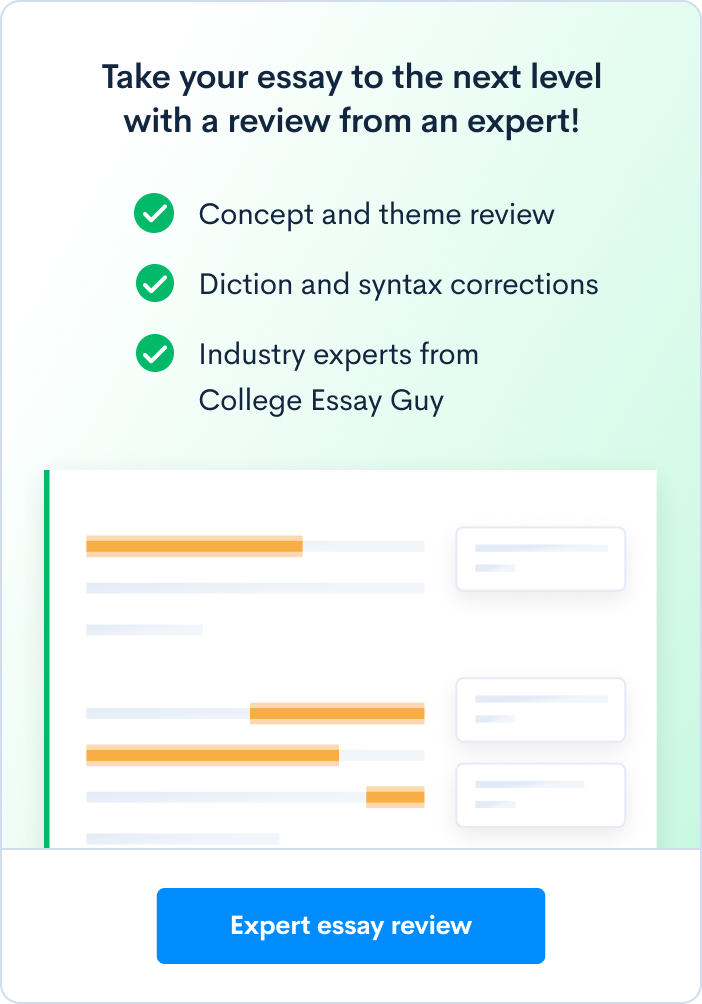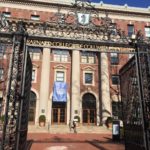3 Strong Boston College Essay Examples
Boston College is a private, Jesuit research university in the greater Boston area known for its outstanding academics and beautiful Gothic architecture. This R1 research university was founded as a small liberal arts college in 1863 and pays homage to its roots by keeping the word “college” in its name.
Admissions at Boston College are quite selective so if you want to become a BC Eagle, it’s important to write strong essays that show admissions counselors your personality and potential. In this post, we will go over real essays students have submitted to Boston College. Walking through the strengths and weaknesses of these essays should help you when perfecting your Boston College Application!
Please note: Looking at examples of real essays students have submitted to colleges can be very beneficial to get inspiration for your essays. You should never copy or plagiarize from these examples when writing your own essays. Colleges can tell when an essay isn’t genuine and will not view students favorably if they plagiarized.
Read our Boston College essay breakdown to get a comprehensive overview of this year’s supplemental prompts.
Essay Example #1
Prompt: When you choose a college, you will join a new community of people who have different backgrounds, experiences, and stories. What is it about your background, your experiences, or your story, that will enrich Boston College’s community? (400 words)
I used to face two paths: one flocked with taxis and frantic people, staccato shouts, and the smell of pizza. The other was a road of motorcycles rolling over wet cement, laced with cicada symphonies and the aroma of beef noodle soup. It always felt easier to walk the streets of Taiwan, where everyone looks like me, speaks meekly as I have been taught to, and steers away from confrontation. However, I was also raised in the thick of New York, where people argue, think, and exist fearlessly. PBS created a documentary in 1988 titled Tug of War: The Story of Taiwan, and I grew to believe that I embodied the little potato island as my teetering balance between two worlds initiated a “Tug of War” within myself. Although I am proud to be Taiwanese, New York has cultivated an unbridled emotion and passion within me that encourages me, against my inherent modesty, to be a bold author, a shameless poet, and a strong-willed advocate for Asian-American youth. I am excited by the vibrant discussions and meshed ideas I might find at a place as diverse as Boston College: perhaps at the Diversity Summit or with Professor Min Hyoung Song about the integration of Asian American writers and literature in an alienating culture. I see incredible opportunities to become part of a community that supports students struggling with their own “Tug of Wars” by sharing my story through the Taiwanese Cultural Organization and delving into the stories of others by curating pieces written by my peers for The Stylus.
Growing up in a pentecostal home also taught me the strength of conviction in faith and community. The Holy Ghost Faith Church is a family that has become a constant foundation in my life, and a world that grounds me in my beliefs despite the cultural identities I struggled with. Through religion, I find connection with many people molded uniquely by their personal experiences. At Boston College, I will seek the same enriched human bonds with my peers and professors by sharing my testimonies while learning from theirs. I can see myself striking up a conversation about religious influences in literature and poetry with Professor James Najarian or joining a multi-faith program and attending local church services with friends on Sunday mornings. While Jesuit education will strengthen my religious values, it will also enlighten me to the beliefs of my peers.
What the Essay Did Well
This essay does a great job of establishing this student’s background and the distinction between their two cultures. There is a great use of imagery, especially at the beginning, which displays this student’s strength as a writer and highlights the internal “Tug of War” they experience. It is evident how their past community has shaped their perspective and identity. Knowing how their background shaped these things makes it easy for admissions officers to see what type of student they would be adding to their campus.
An example of this can be seen through the student’s creative integration of the “Tug of War” metaphor. Early in the essay, the student creates an interesting image of themself caught in a “Tug of War” between two cultures. Then, when they start discussing BC, they reuse this already-personalized metaphor—“I see incredible opportunities to become part of a community that supports students struggling with their own “Tug of Wars” by sharing my story through the Taiwanese Cultural Organization and delving into the stories of others by curating pieces written by my peers for The Stylus.” Because they already established a personal connection with the “Tug of War” idea earlier, this section doesn’t feel like the student is simply name-dropping university programs and instead feels like they are authentically drawn to university programs.
With regards to organization, this student effectively divides their essay into two paragraphs that answer the prompt in two different ways. While this is not always the best strategy and cohesiveness is important for college essays, it works for this student because their second topic is faith. Simply put, using more words to discuss their cultural background and interests would have become repetitive and writing an entire essay about religion is typically unadvisable. However, by supplementing their discussion of culture with a discussion of faith, this student appears multidimensional.
Note: For most schools, focusing on faith in your essay is not recommended, but because Boston College is religiously affiliated, this student’s “cherry on top” discussion on faith works well.
This essay makes readers feel like the student is genuine, interesting, and genuinely interested in contributing to the community at Boston College.
What Could Be Improved
The second paragraph of this essay (the paragraph that discusses faith) could be improved through more engaging writing. While the student’s integration of information about BC feels natural when they are discussing culture, it feels inorganic when they discuss religion. The essay ends with the following sentences:
The student’s descriptions of forming bonds through religion are not as engaging as their writing above and the inclusion of a professor’s name does very little here. Instead, the student could have created an image of their life at BC and reminded the reader of their vivid images from earlier. Improvement could look something like this:
“Now, when I think about community, I imagine myself in the dining hall. Through some series of unexpected events, I find myself in an intense intellectual discussion about the influence of religious propaganda on the Wife of Bath’s Tale. Sometime during our back-and-forth, I start to enjoy and respect my impromptu debate opponent. I picture us (after emerging from the heat of our debate) chatting and deciding to check out a local church service together on Sunday morning. It feels like a dream—like another scary path, without taxis or motorcycles, but dotted with intimidating social situations and an infinity of uncertainties. But it also feels like the most promising opportunity of my life.”
Essay Example #2
Prompt: When you choose a college, you will join a new community of people who have different backgrounds, experiences, and stories. What is it about your background, your experiences, or your story, that will enrich Boston College’s community? (400 words)
I gazed at my Beyer book and the monochromatic piano keys. Notes swirled in my head as I struggled to decipher the crochet on the page. Taking my chances, I pressed the D key, positive that I was right. Alas, my tutor’s sigh indicated that l got the note wrong again.
Growing up, I often faced such mishaps during piano lessons. My grandma is an avid singer and my grandpa, a violinist. My cousins are also guitarists. From being brought up around my family’s deeply rooted musical inclinations, to constantly struggling during practice sessions, I often felt like a fish out of water and wanted to quit. Music was a chore, something I felt obligated to pursue only to uphold my family’s tradition. However, one fateful session completely changed my view.
Back then, I had spent hours glued atop the piano stool practicing for a recital, and I felt completely drained. Needing a break, I grabbed my phone and turned on some pop music. As Rihanna’s “Diamonds” blasted away, I couldn’t help but notice how similar it sounded to several musical scales I had learned. Curiously, I attempted to match some notes to the song, and before I knew, I was playing the entire chorus! It dawned on me that those scales and arpeggios I found irritating formed the basis for an endless array of songs when combined strategically and originally.
From then on, I started to see music as my favorite creative challenge rather than a nuisance. My new perspective eventually led me to embrace every struggle I faced during practice and instead view them as opportunities to improve. As I came to love every step of my musical journey, I ultimately learned to persevere through any setbacks, like dealing with unfamiliar pieces or memorizing notes on end.
Music has become something more than a family tradition, shaping who I am today. Thinking creatively and overcoming struggles with determination are now values I carry when tackling everyday roadblocks. Going forward, I plan to bring these values to BC. I’m determined to use creativity to help solve communal problems, like finding innovative ways to implement healthcare in underserved communities through Timmy Global Health. I also hope to contribute musically to the Symphony Orchestra and be part of a nurturing community where I can work alongside other musicians. I’m excited to see what the future holds when I become an Eagle!
What the Essay Did Well
This essay answers the prompt very clearly. When asked “What about your experiences will enrich Boston College’s community?” the student’s essay, as a whole, responds “As a musician, I have learned to persevere through setbacks and that will enrich the Boston College community.”
Additionally, the student organizes their essay in a way that makes it easy to follow. They start by discussing their upbringing, then a major transition, and then they use the final paragraph to reflect. In the final paragraph, they also refer back to their upbringing—“Music has become something more than a family tradition, shaping who I am today”—effectively bringing things full circle. This makes the essay feel cohesive and tied up.
This student does a very nice job setting up their story, showing the reader why this was an important revelation for them. Taking the time to explain the different instruments each family member plays is a good way of showing this student’s musical background, making their burden to “uphold my family’s tradition” all the more understandable. Once there is a solid appreciation for this student’s circumstances, it allows the reader to sympathize with their struggle and ultimately celebrate their victory.
What Could Be Improved
The largest fault of this essay are the grammatical errors and clunky language throughout the piece that diminish the overall quality of the story. They use simple transitions that feel forced. For example, their body paragraphs begin with “Growing up,” “Back then,” and “From then on,” These boring transitions are not engaging and seem elementary.
They also have multiple poorly-written sentences including “Thinking creatively and overcoming struggles with determination are now values I carry when tackling everyday roadblocks.” The overuse of gerunds here distracts from what the writer is trying to say.
A final example of this essay feeling unpolished is the student’s improper use of the from-to construction with the sentence “From being brought up around my family’s deeply rooted musical inclinations, to constantly struggling during practice sessions, I often felt like a fish out of water and wanted to quit.” The from-to construction should outline two extremes that independently exemplify the independent clause that they are connected to.
Instead, the student could have written “From crying late at night about missed notes to struggling through practice sessions, I constantly felt like a fish out of water in my musically-gifted family.” Small but noticeable language errors like this one illustrate the importance of having others edit your drafts!
Essay Example #3
Prompt: At Boston College, we hope to draw on the Jesuit tradition of finding conversation partners to discuss issues and problems facing society. Who is your favorite conversation partner? What do you discuss with that person? (400 words)
Instead of admiring towers of multi-colored cupcakes, Asher and I found ourselves staring at a menacing yellow bulldozer, caution tape barring our path. Turned in circles, looking askance at our surroundings, Asher and I immediately began to squabble:
“Margot, how could you mess it up??”
“I followed the directions….”
“Well, clearly you didn’t since we’re here and not at the bakery.”
“You didn’t have to follow me!”
I retraced our steps on Google Maps, insisting that the directions were flawed—not me. My voice faded as I scrutinized the outlined path. I found our error: I had confidently led us right down Broadway instead of left.
Since we were four, Asher and I have been best friends, and our friendship is founded on three principles: adventure, food, and FAMU (fight and make up). From hide-and-go-seek to mastering the metro system, our shared love of exploration dominates our time together. We converse about everything from where we one day hope to travel to the best dumpling places and most engaging museums. However, as two directionally challenged individuals, we routinely end up lost on our way to try new things. As a result, we frequently discuss directions: debating optimal routes, arguing when we mess up, then analyzing how to undo our errors best.
As we anxiously bickered at the construction site, our fight progressed toward problem-solving.
“I guess we could retrace our steps.”
“No…look! There’s a pedestrian path over by the cones. Let’s see where it goes.”
Following the path, we talked solely about our frustration and annoyance about getting lost. But, as we emerged on the other side of the construction site, we spotted the bakery we had been searching for. Our disastrous detour was actually a secret shortcut.
Inspired by our unintentional discovery, Asher and I shared an epiphany: for too long, we focused on the negatives of getting lost rather than the positives. And our conversations reflected our pessimistic attitudes. Now, I make an active effort to replace phrases like “this is all your fault” and “the directions are wrong” with “let’s get lost” or “forget the directions.” By celebrating the beauty of getting lost, I have learned that there is no singular right way to get where I am going. Sometimes the unexpected pans out in unpredictable yet incredible ways.
Asher and I no longer fight about directions; now, we excitedly discuss getting lost.
What the Essay Did Well
This prompt wants to hear about your conversations with someone special, and this essay delivers! The best way to make your essay immersive is to include actual lines of dialogue you and your conversation partner have had. We get to see the frustration, sass, and bickering of the student and her friend instead of just being told about it. Just six lines of dialogue bring a whole new dimension and level of characterization to these two.
Beyond the conversation snippets, the level of detail this student incorporates makes the essay more engaging. From the first sentence, we get descriptions like “towers of multi-colored cupcake,” “menacing yellow bulldozer,” and “caution tape barring our path.” Her detailed writing continues with concrete examples of what she and her friend discuss, beyond the incident at the heart of this essay: “We converse about everything from where we one day hope to travel to the best dumpling places and most engaging museums.”
Another positive of this essay is this student’s concise writing style that lets her voice shine through. Despite being a story about getting lost, this essay has a light-hearted and somewhat humorous mood. This student is able to accomplish that because she gets directly to her point, saving space to inject a little fun into her writing. She perfectly encapsulates her friendship for the reader in three points—”adventure, food, and FAMU (fight and make up)”—humanizing them in a quick and entertaining manner. Additionally, describing them as “two directionally challenged individuals” is a straight-to-the-point descriptor that also pokes fun at their weakness.
Overall, the reader walks away from this essay being able to imagine exactly what a conversation between this student and her friend sounds like, which is a great accomplishment.
What Could Be Improved
One of the weaker aspects of this essay is the reflection in the conclusion. Although the student is trying to demonstrate her growth and new perspective from the experience, it feels a little forced. Generalizing the acceptance of getting lost to the idea that “there is no singular right way to get where I am going” comes off a bit cliche without further elaboration.
In order to make the conclusion feel more genuine, this student should have included an example of a time she applied this lesson to her life. Maybe she always thought she should be a doctor, but she allowed herself to get lost researching topics in her biology class and stumbled across biomedical engineering and has now decided to pursue that. The one risk with this approach is making sure there is enough space in the conclusion to elaborate with a sentence or two. You don’t want to go from talking about getting lost trying to find a bakery to studying biomedical engineering in one sentence. But, if the student found a way to rework her conclusion to make it less theoretical, it would come across as more sincere.
Where to Get Your Boston College Essays Edited for Free
Do you want free, nearly-instantaneous feedback on your BC essays? After rereading your essays countless times, it can be difficult to evaluate your writing objectively. So meet Sage, our AI tutor and advisor, who will rate your essay, give you suggestions for improvement, and summarize what admissions officers would take away from your writing. Sage can improve your chances of acceptance to your dream school by helping you show what you have to offer beyond the numbers!




